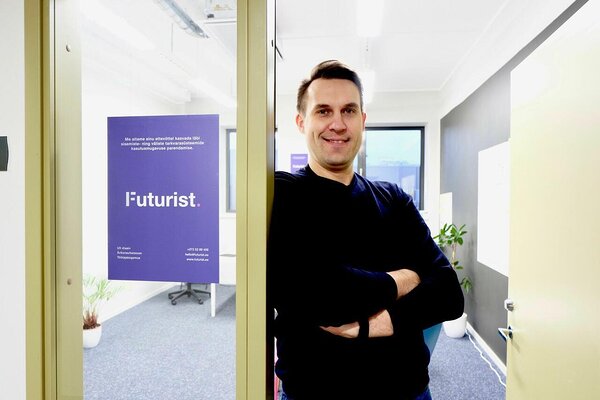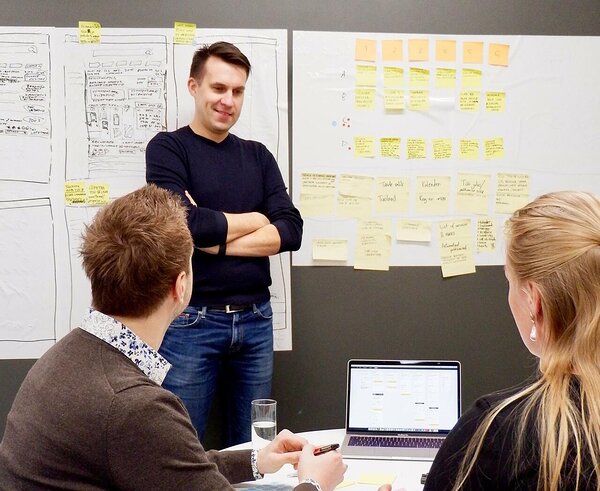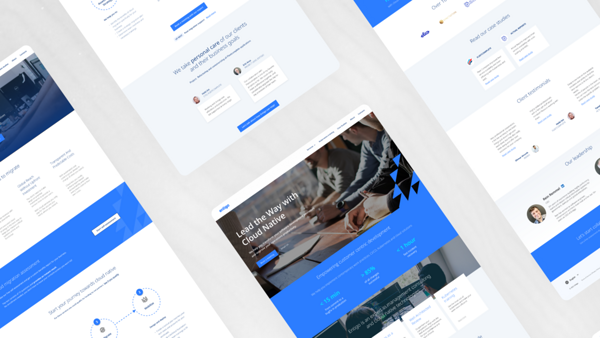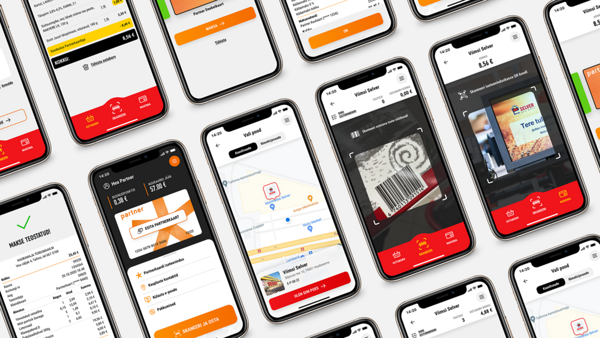Meet Futurist Estonia
Futurist helps companies achieve their business goals by developing and improving the quality and ease of use of their digital services.
Our questions about Futurist Estonia will be answered by Andres Kostiv, digital services strategist and UI/UX designer.
On the photo: Andres Kostiv, Futurist Estonia Digital Services Strategist and UI/UX Designer
What is Futurist Estonia and what type of design-related challenges do you predominantly work on?
Futurist is a company focused on developing digital services and strategies. Our primary focus is to help companies achieve their business goals by developing and improving the quality and ease of use of their digital services. The business challenges that we work on are very diverse and generally span the entire life cycle of companies. Be it an idea for a brand-new product or service that is still to be validated or an already existing service whose revenue is to be increased. Or perhaps there is a wish to improve some commercially important internal processes and ease of use for the company’s employees. The common denominator is always a business challenge to solve through design, and a tangible result is usually an increase in revenue or profits, or cost savings.
What characterises the work(s) of design agency Futurist Estonia, what is your strength?
The uniqueness of Futurist Estonia lies in the speed at which we develop digital products and services, for which we use the bespoke Google Design Sprint methodology. Design Sprint helps companies create and validate their new product or service ideas in just four days. While it can usually take several months or more to launch an update for a new product or service, a Design Sprint makes it possible to accomplish that in just a week. This saves a tremendous amount of development resources, time, and money, and it allows you to validate and improve your ideas before they proceed into final development. Since the final result of a Design Sprint is always a tangible prototype that has also been tested and validated by end users, the Sprint also acts as a kind of insurance. After all, finding out within four days that your initial hypothesis did not work is much better than spending several months working and only then realising you have to start all over again.
Based on the Design Sprint methodology, we have also created a special Strategy Sprint that helps a company to determine its overall focus and goals better and create a more concrete strategy and action plan. And although the keywords that characterise us are sprint and speed, we can also move at a calmer pace. There are quite a few challenges where speed is not always the primary concern, as well as clients who want to move at a calmer pace with their developments.
On the photo: Andres Kostiv leading the design sprint
What are the most successful projects of Futurist Estonia thus far, and why? Which of these is your favourite?
There are many successful projects from very different fields. These include apps, self-service solutions, online stores, mission-critical services, as well as development of internal processes. One of the biggest recent projects has been the launch of the Partner Card app and the mobile self-scanning option it provides, which had more than a hundred thousand users already in the first few months. It was a very exciting project, to make it possible for the client’s own smartphone to provide a world-class, comfortable and intuitive shopping experience. With our Design Sprints we created a new self-service, web design, and content with videos for Entigo, in order to support their export ambitions. The launch of the Zone self-service environment has also been memorable, as it was a commercially interesting challenge and a high-impact project for the company. Mission-critical services also come to mind, where we were able to help with designing a work system for the next generation of police investigators and creating a concept of a procedural process. We've also helped emergency medical services by creating an iPad app for medics so they can improve their work process in the ambulance.
A memorable project from last year has also been the new website and concept for Padise Monastery, which was made in cooperation with the Estonian Design Centre’s mentoring programme in the spring. This was an interesting project, as with Padise Monastery, we are not only dealing with an attraction and its website, but it connects the whole of Lääne-Harju as a tourism region into a unified portal.
On the photo: Entigo website
What inspires you? From where do you draw inspiration from on a daily basis?
As a designer, my eyes are open at all times. I find inspiration both in the urban space and on my travels, and over time, I have learned to notice the design around me more. Both good and bad. Sometimes even a tasteless design that makes you smirk can be a good source of inspiration, by leading you in the opposite direction, that is. For me, design is, first and foremost, a means of solving a problem or challenge, and it pleases me to see when someone has solved it well, be it in the form of an e-service, an app or also through the use of urban space.
There are also several companies that I am a fan of. I have been a big fan of the whole world of Nintendo since I was young; with both their PC games and consoles, the user experience is delightful, even for adults. I'd definitely like to see more of the use of gamification in different services and situations, and there's a lot to learn from Nintendo.
Another great source of inspiration and influence for me is Apple. Not only in the form of their products today but also in the philosophy and methodology of their design and product development over several decades. I think my home library has almost every Apple-related book ever published.
In terms of design, there are two people – in my eyes, legends – that have influenced me the most: Don Norman and Steve Krug. Both are, in my opinion, the fathers of user-centric and empathetic design and design thinking.
I also get professional inspiration from various blogs that I follow, such as uxmag.com, www.smashingmagazine.com/category/ux and marvelapp.com/blog
What is your main customer profile? What type of projects do you cherish most?
There is a wide variety of companies, both from the private and public sectors and from different fields of expertise. For example, there are technology, financial sector, service, commerce, medical, media, and entertainment companies. There are companies that have been operating for a longer time, and there are businesses that are in their early stages of growth. However, the common denominator for every company is the provision of a specific service through digital channels and the desire to grow their business.
The projects that we cherish the most are those where, in addition to visible design changes, we can also see the clear business impact on the company's results later on. Be it a clear increase in revenue in a product category, an increase in service subscribers in a particular channel, or any other business metric set by the company. Sometimes it is also gratifying to see that during our work, it already becomes apparent in the beginning that the initial concept does not work, but we can still help develop, validate, and successfully launch the initial concept through several iterations and user feedback.
On the photo: Partnerkaart app
What do you consider to be the most important thing about design? Is it the concept, ideas, form, problem-solving, or something else?
Referring to the previous answers, the most important thing for me is that the design would help solve a specific challenge or business problem. In general, companies themselves already have a clearer understanding of their business problem. Still, it can often also happen that the initial problem that was addressed to us is turned upside down during our work and together with the company, we help them sort it out better. Therefore, we consider it extremely important to validate that we are indeed starting to solve the right problem. For that, we use different design process tools, and we have also developed our own special Strategy Sprint Toolbox, which is helpful for those companies that also need support to establish their business focus and action plan.
An essential aspect of design is that it would actually help to make users' lives better and more comfortable as a result, and that using products and services would offer more positive emotion. This is why I consider it very important to get feedback from users as soon as possible when working with design, so that the gaps between the iterations of the improvements do not become too long and the development process does not drag on. As a designer, I rejoice when I see that our work has made life better for the end user, and, as a result of that, the company has also achieved its business goals.
What type of clients are you hoping to work with more in the future and what type of projects and in which fields would you prefer to take on?
I still see a lot of potential in the development of e-commerce cross-selling, upselling, and various self-service environments, both in the private and public sectors. As end-users who are used to having things work with a few clicks and taps of a button on our smartphones, our expectations of digital services are ever-increasing. Meanwhile, it can be clearly seen that not all fields have caught up with these developments. I see this in e-commerce, financial services, and public sector services. I also see a lot of room for improvement in terms of the accessibility of digital services, which do not seem to be sufficiently taking into account our ageing society and people with special needs. In addition, the issues of circular economy and sustainability are important.
The fields that fascinate me very much are also aeronautics, the automotive industry, and the manufacturing industry and national defence. As well as all sorts of mission-critical services and challenges such as finance, medicine, and energetics. And although there already are some start-ups in our portfolio, we would definitely like to see more of them. When start-up companies may not find their way to us in their earlies stages, then there will definitely be enough companies that have already proven themselves to some extent, who are quietly moving into a phase of faster growth and have the desire to take their business to the next level with strategic thinking and design methodologies.
What is the ambition of Futurist Estonia? Where do you see yourselves in five years?
Our ambition is to develop the best digital services and make more and more people happy by improving their exposure to technology so that they have more time for their families, hobbies, and other important matters. The focus of Futurist Estonia is and will remain to be on the rapid development of digital services, but we can already see today that more and more customers need support not only with developing their services but also with getting their strategic focus and action plans in place, as well as to create clearer value propositions and messages when launching their services. In five years, we will see that the number of clients whom we can help in an even more versatile manner than we do today will definitely increase.
And lastly... what are some must-have playlists/movies/series that you believe should also reach others?
One series that has influenced me as a designer is Lella & Massimo Vignell's documentary Design is One. It's a great insight into the mindset and philosophies of designers. I also follow the Design Course channel on Youtube, which helps to keep me up to date with new design software and developments and is overall a good source of inspiration. Regarding films, I would like to point out some of my favourites from the last couple of years – House of Gucci and Elvis – which have left an indelible impression on me as a hobby filmmaker, precisely in terms of cinematography. The movie soundtrack playlists of both films are also a frequent companion for me at work.



